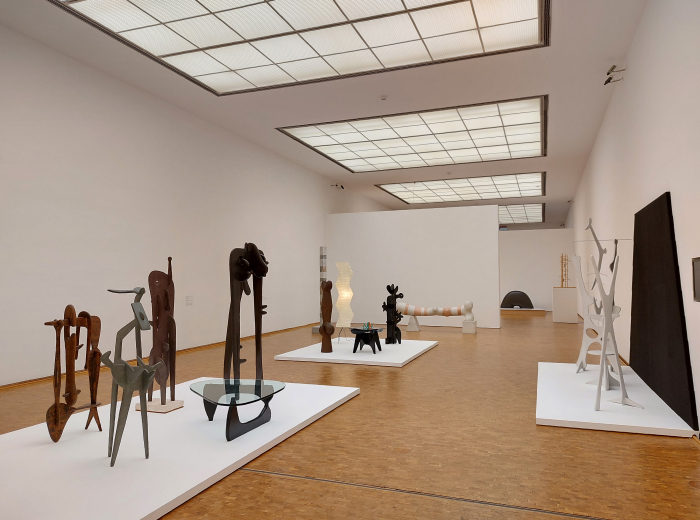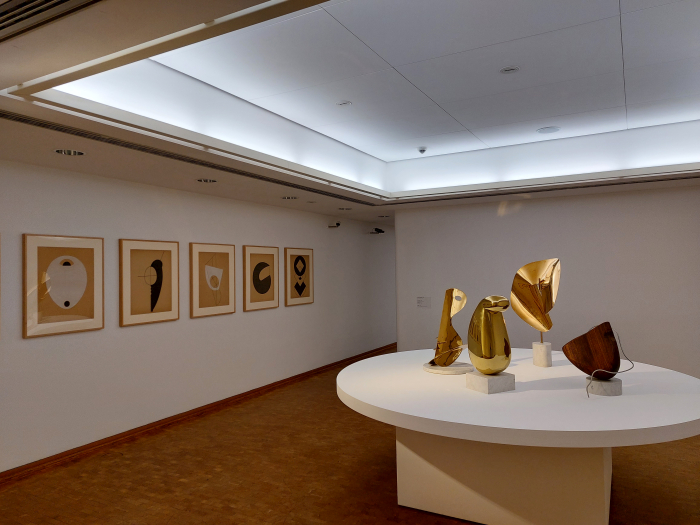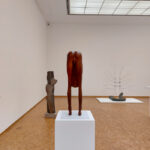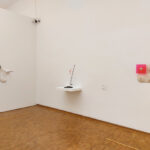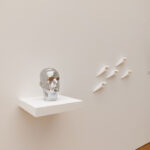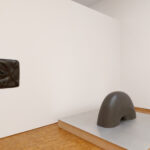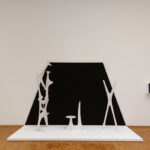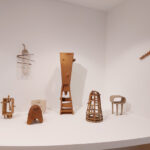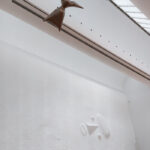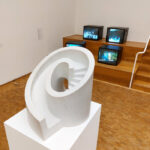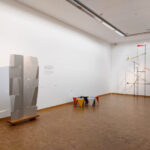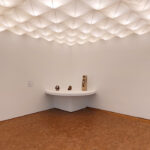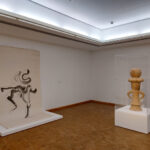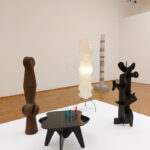Isamu Noguchi at the Museum Ludwig, Cologne
“Everything is sculpture” opined once Isamu Noguchi.1
But is it?
The exhibtion Isamu Noguchi in the Museum Ludwig, Cologne, allows one to engage with, reflect on, immerse yourself in Isamu Noguchi’s life and work, and thus to better approach your own opinion on Isamu Noguchi’s firmly held conviction…..
Born in Los Angeles, California, on November 17th 1904 to an American mother and a Japanese father we’ve discussed the Noguchi2 biography on several occasions in these dispatches and so refer you there dear reader for the details, and cut straight to Isamu Noguchi, a co-production between the Museum Ludwig, the Barbican London, the Zentrum Paul Klee Bern and LaM Lille, and one of the first major Noguchi retrospectives in Europe for the better part of a generation.
A gap, a gap in the development, advancement, of popular understandings and appreciations of Noguchi, and for all a corresponding fading of popular understandings and appreciations of the contribution and relevance of Noguchi, that becomes increasingly apparent the longer one wanders around and through Isamu Noguchi.
Tracing both a thematic and, more or less, chronological path through the life and work of Noguchi Isamu Noguchi, more or less, opens in the late 1920s, when, and shortly after quitting his medicine studies in favour of art, Noguchi was awarded a John Simon Guggenheim Fellowship which he used to relocate from New York to Paris with the plan of studying under, apprenticing to, the Romanian sculptor Constantin Brâncuși. A plan that, so the popular re-telling of the tale, was initially thwarted when Brâncuși announced he had neither need for nor interest in an apprentice. But, replied, Noguchi, with one senses an audacity only someone in their early 20s can muster, you could probably use a stone cutter? An offer Brâncuși could barely refuse, and thus over a period of some six months the young Noguchi worked alongside not only one of the most important and interesting European sculptors of the early 20th century, but a sculptor who was a major influence on Noguchi’s understandings and approaches. Something tending to be testified to by a collection of 3D and sketched abstractions from 1928 which although presented at the opening of Isamu Noguchi in many regards also run through it.
From Paris Noguchi travelled, as does Isamu Noguchi, to Japan and China, further not irrelevant impulses in the personal and professional development, journey, of the young Noguchi, before Isamu Noguchi arrives at two of the central themes of Noguchi’s oeuvre, one could argue two of the dominant themes of Noguchi’s life: society and activism.
Activism which, as Isamu Noguchi helps elucidate, began in the 1930s with projects such as, and amongst others, the unrealised, Monument to the Plow from 1933, a monolithic mound of earth as a comment on the crop curtailment programme in force at that period as part of the US Federal government’s response to the developing Great Depression, while also reflecting on the relationships between peoples, nations and their soil, on belonging, and a work which in many regards predicts aspects of Land Art/Earth Art; the, similarly unrealised 1933 work, Carl Mackley Hosiery Workers’ Memorial, a work in memory of one Carl Mackley who, during a strike at the H.C. Aberle and Company hosiery mill in Philadelphia, was killed, murdered, by a non-striking, anti-strike, colleague, a work which can also be considered as a memorial to all victims of workers’ rights movements, and a work which in many regards predicts aspects of Pop Art sculpture. Or by the realised, but sadly only represented in Isamu Noguchi as a photo3, Death (Lynched Figure) from 1934, a work depicting a twisted, contorted black figure hanging from a gallows, a work created by Noguchi as a response to the 1930 burning and lynching and re-burning of the black man George Hughes by a white mob in Sherman, Texas, and a work which was presented at the 1935 exhibitions An Art Commentary of Lynching and Struggle for Negro Rights, both of which were part of a movement at that time in the USA to legally oblige the American police to actively intervene to stop lynchings. No honest.
And a social activism which, as Isamu Noguchi helps further elucidate, moved increasingly into deeper and more differentiated considerations on the nature and fabric of society in the wake of the Second World War.
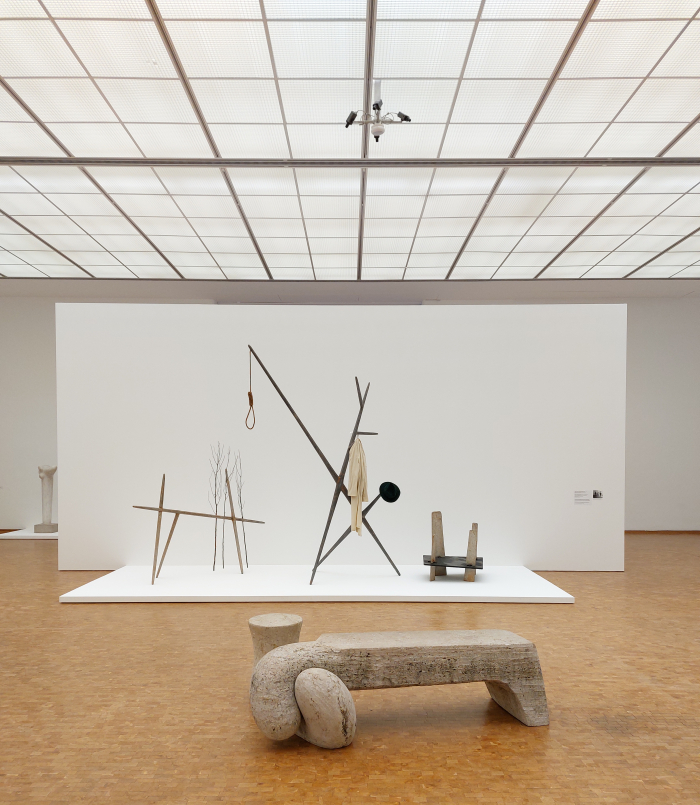
Props for Erick Hawkins’ 1945 production John Brown (God’s Angry Man), and a granite bench, by Isamu Noguchi, as seen at Isamu Noguchi, Museum Ludwig, Cologne
Throughout his life Noguchi was greatly influenced and informed by his joint American/Japanese biography, as a child he spent a great deal of time in both countries, felt drawn to both, if unsure of where or how he fitted in to both, to either, or as he once phrased it, he possessed “a haunting sense of unreality, of not quite belonging, which has always bothered me”4; and then suddenly the two parts of his being were at war with one another. Not just the on-going figurative, emotional, psychological conflict between the two parts of his being undertaken within him, but an actual physical war.
An actual physical war which caused Noguchi to reflect more openly and honestly that he, arguably, ever had on the two parts of his biography, and of what it meant and means to be Japanese in America, for all what it meant and means to be a Nisei, a second generation Japanese migrant in America, something which as a 1942 text on display in Isamu Noguchi confirms Noguchi felt he became during the War5, in his late 30s. And reflections that took on a whole new context and relevance in the wake of the dropping of the atomic bombs on Japan by the USA. Events noted in Isamu Noguchi by two, unrealised, monuments for Hiroshima Noguchi developed in the early 1950s. Just two of Noguchi’s many reflections on and responses to the events of August 1945 to be found both in the Noguchi canon and in Isamu Noguchi.
And an actual physical war that Noguchi partly experienced in an internment camp for Japanese-Americans in Poston on the edge of the Arizona desert; a voluntary internment on Noguchi’s part undertaken both out of a sense of solidarity, but also with the intention of contributing to the improvement of camp life for those Japanese-Americans obliged to live there, through, for example, art classes or a comprehensive (urban) planning concept he developed and which, as can be seen in Isamu Noguchi, in addition to medical, catering and sports facilities, also featured a theatre, a zoo and a botanic garden. A plan, perhaps unsurprisingly, that was never realised; and a stay in Poston which generally didn’t turn out as Noguchi had envisaged, and became, one gets very much the feeling, a place of physical and mental torture, before he was allowed to leave in November 1942 and return to New York.
If, arguably, not the same Noguchi who had left New York for Poston some six months previous.
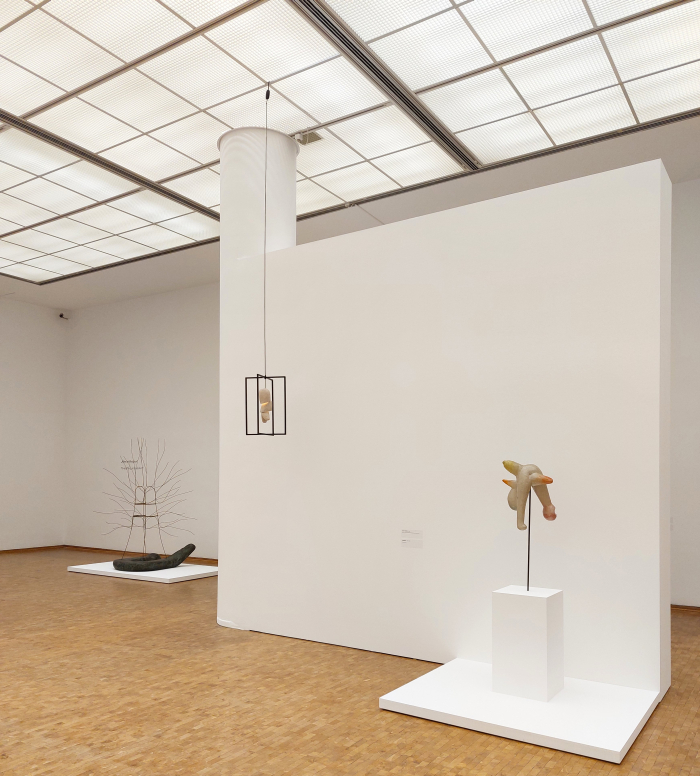
The works (r to l) Spider Dress for Martha Graham, Lunar Infant & Untitled by Isamu Noguchi, as seen at Isamu Noguchi, Museum Ludwig, Cologne
As Noguchi later noted his time in Poston fired within him a “never-ending yearning for a brighter world”.6 A yearning that on the one hand expressed itself in evolutions in Noguchi’s view of and approach to society and the world around us, as a yearning for a metaphysical brighter world which remained an important impetus in his life and work, but also expressed itself physically: as previously discussed that yearning led to those works for which Noguchi is today most popularly known, the Akari lamps. Works pleasingly barely present in Isamu Noguchi, we counted but 4; and pleasingly because they do tend to, if one so will, place the rest of Noguchi’s oeuvre in their shadow. Which as Isamu Noguchi ably demonstrates is not only unjust, but is also to deprive us all of a great many other delights. Yet while the Akari themselves are (all but) absent the path Noguchi took to Akari, the path, the journey, to the “sculpture that had a controllable light”7 he had envisaged making in Poston, can very much be followed in Isamu Noguchi through works such as Lunar Infant and Lunar Landscape from 1944 or the ever joyous 1943 Monument to Heroes, a work thankfully on display in Isamu Noguchi, a work of bones and splinters of wood puncturing a dark tunnel to reveal the light, and a work of simultaneous beauty and violence, harmony and disharmony, despair and hope, that one cannot but engage with it. Or but feel with.
And just one of several works in the Noguchi canon, and in Isamu Noguchi, which owe a larger part of their genesis and their expression, their voice and being, to Noguchi’s experiences in and of the Second World War, including, and amongst others, My Arizona, Double Red Mountains or, and amongst the more graphic, if understatedly so, works on display, This Tortured Earth: a monument to the horrors of war that employs and emphasises the physical damage done to planet Earth by war as a means of admonishing against war, and which foresaw using the weapons of war as tools to form a permanent sculpture on the surface of the Earth from the surface of the Earth. A project that, in certain regards, can be considered a variation on the Surrealist’s Readymades, certainly as an early expression of Land Art/Earth Art, if a project that never got beyond the 1942/43 bronze object that hangs in the Museum Ludwig.
Or at least Noguchi didn’t take it further; however, in the intervening eight decades This Tortured Earth has been recreated by innumerable and insufferable wars across our planet, wars that have continued to damage our planet physically, emotionally, culturally, socially, for if we wound our earth do we not wound ourselves? And not just by war, but by deforestation, industrial agriculture, ore mining, microplastics and the myriad other manners we’ve contrived, and are in the process of developing, to torture Earth.
Thus a work, a position, that has lost none of its urgency.
A contemporary relevance in the works and positions of Noguchi to be found throughout Isamu Noguchi.
And a reminder of the contemporary relevance of Noguchi, a filling in of the gap that exists in popular understandings of the relevance of Noguchi, and also a filling in of the gap that exists in popular understandings of the contribution of Noguchi to art, to the development of art and artistic practice, to the development of art’s relationships with humans and societies, Noguchi’s contribution to moving art on from pour l’art, his contribution to expanding the function of art, a reminder that when Noguchi began his career sculpture was a relatively narrowly, restrictively defined genre, one he helped broaden. Reminders and filling in of gaps that are just some of the many joys of Isamu Noguchi.
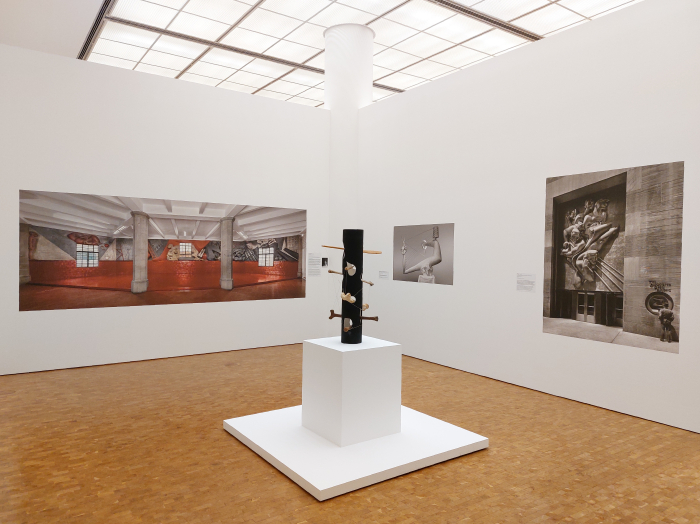
Monument to Heroes by Isamu Noguchi alongside examples of some of his political 1930s works, as seen at Isamu Noguchi, Museum Ludwig, Cologne
Presenting some 150 works from across the six decades of Noguchi’s creativity, Isamu Noguchi provides for a very accessible, well-paced, introduction to the life and work of Noguchi, and it can be but an introduction, prolific is a word barely suitable to describe Noguchi’s output, nor intricate a suitable enough word to describe Noguchi. One is always at the beginning of an exploration of Noguchi.
But for all its necessary brevity Isamu Noguchi provides for an introduction that allows access to the many and varied and divergent aspects of Noguchi’s life and work including, and amongst others, the many personal and professional relationships which informed and sustained his work, such as, for example, his great friendship with Richard “Bucky” Buckminster Fuller which in addition to the future-orientated stimuli and openness for new technologies and materials it brought Noguchi also links Noguchi to a Charles & Ray Eames and to a George Nelson for whom Noguchi, possibly, designed the Ball Clock; allows one to better appreciate the importance of the many creative movements with which Noguchi was associated and with which he experimented, including Surrealism, a relationship highlighted, for example, by the chess table Noguchi created for Marcel Duchamp and Max Ernst’s 1944/45 New York exhibition The Imagery of Chess; allows one to better appreciate the role and importance of play and of public space design in Noguchi’s understanding of his work, in, if one so will, his understanding of his function as an artist, and the function of sculpture, something neatly encapsulated in the, unrealised, 1933 project Play Mountain; allows one to better appreciate the importance of materials in Noguchi’s work, although he employed a great many materials he was always very specific in his choice of materials, noting once that he was “wedded to the idea that an intrinsic quality resides in materials”8, and working with, discovering, that quality, is and was an important element of Noguchi’s art; allows one to better appreciate the calmness of Noguchi’s work, even at its most violent there is no hurry, no frenzy, no physical or emotional force is exerted or demanded, much more one is subject to a questioning, a patient, calm, if insistent, questioning; allows one to better appreciate the very close connections between Noguchi’s work and positions and the world tangible and intangible which surround us, that those works are both informed by those worlds and inform them. Or allows one to better appreciate the importance of his numerous scenography commissions to the development of his art, to the development of his understandings of time, space, relationships, scales, movement, his understandings of sculptural interactions, of sculpture as interaction. And which through his props for Martha Graham’s 1944 Hérodiade (Mirror Before Me) bequeathed us all a chair that is without question the great lost Noguchi furniture design.
While in its variety and scope Isamu Noguchi also allows one to better appreciate that for Noguchi sculpture wasn’t passive, wasn’t something to look at, but something to be experienced with the mind and body as a single entity; and also to better appreciate the manner in which Noguchi’s oeuvre is interlinked: as with the many inter-locking sculptures which dominate the main exhibition space, Noguchi’s canon contains no autonomous components, no unbroken straight lines, rather is a splicing and association of parts which for all that they can be easily individually identified and sketched, are all dependent on one another, all refer to and support one another, are all essential components of the whole. And should any piece be removed not only would the composition lose it’s validity and become restricted in its communicative faculties, but the individual piece would become essentially irrelevant. Certainly become unreadable.
Or put another way.
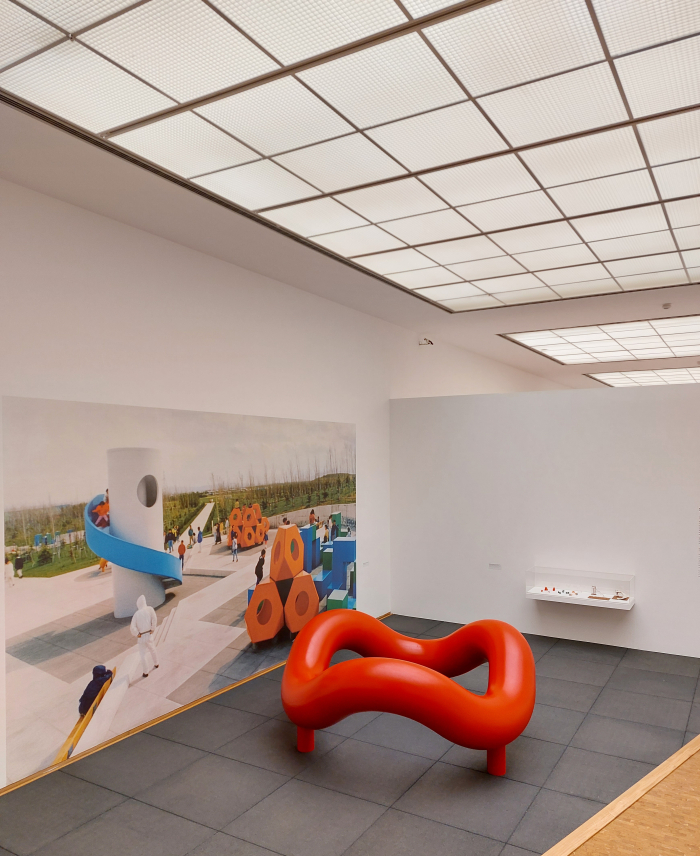
Play Sculpture by Isamu Noguchi, and on which you can play. Or Sit. As seen at Isamu Noguchi, Museum Ludwig, Cologne
One of the first objects one meets in Isamu Noguchi, and we believe in this context the word “meets” is correct, is a 1933 sculptural self-portrait, a deliciously self-effacing and humourful work devoid of any pretensions or self-reverence, other than perhaps a little, well justified, pride in his suppleness, and a self-portrait which leads on into a presentation of busts, an early source of income for the young Noguchi as he sought to establish himself in 1920s and 30s New York. If a source of income he came to despise, a creeping disdain he often cites as a motivation to develop early 1930s works such as the aforementioned Play Mountain and Monument to the Plow, a questioning of what he was doing that became a questioning of sculpture; and busts of individuals such as Uncle Takagi, the painter José Clemente Orozco or the journalist Suzanne Ziegler very cheekily, and very very satisfyingly, extended by Noguchi’s 1937 Radio Nurse, one of the first commercial baby monitors, a very neat example of the advantages of Bakelite, Friedrich von Borries’ start of the soft path to our contemporary surveillance society, an object that contains unmissable references to the influence of a Constantin Brâncuși, a quasi-Surrealist object reminiscent of, depending on your viewpoint, a Kendo mask or tender human head adorned by a nun’s veil, and one of Noguchi’s earliest product designs.
A branch of Noguchi’s oeuvre represented throughout Isamu Noguchi; and products whose self-evident, unquestioned, omnipresence amongst works such as, for example, Death (Lynched Figure), My Arizona, Cronos or This Tortured Earth, a motif Radio Nurse very neatly sets up and which can also be understood in the free, untroubled intermingling of works such as, for example, Death (Lynched Figure), My Arizona, Cronos or This Tortured Earth with, for example, Noguchi’s scenography for Erick Hawkins’ 1947 work Stephen Acrobat, examples of his landscape and garden designs or his Play Sculpture for children’s playgrounds which visitors of all ages are invited to sit on, climb on, whatever, helps remind us all that while Noguchi is, certainly in a European context, popularly known today as a product designer, an understanding of Noguchi, we’d argue, very much related to the lack of major Noguchi retrospectives in recent years and which has seen care of the popular Noguchi legacy left very much in the hands of furniture manufacturers, for Noguchi the separation between the various aspects of his oeuvre was never that distinct, for although very much aware of the differing demands of the differing aspects of his oeuvre, not only for him were they all linked, all dependent on, referenced to and by, supportive of, one another, as part of a constitute whole outwith of which they lose their relevance, but for Noguchi everything was, is, sculpture: “any material, any idea without hindrance born into space, I considered sculpture”.9
Or, and to expand on the quote with which we opened this post, for Noguchi, “your environment is your sculpture, your world. It’s the world, and the world then becomes a sculpture. So everything is sculpture. I think I’m a megalomaniac.”10
We don’t think you are. We’ve seen your self-portrait. And fleeting insights into your view of the world.
But is everything sculpture?
Or is that just Noguchi’s view, the result of Noguchi’s personal and professional journey, a conclusion reached on account of Noguchi’s unique personal and professional explorations, reflections and questioning? An artist’s view?
Or is everything sculpture?
And if it is, who’s sculpting?11
And that would mean…….?
Through its clear and comprehensible presentation of Noguchi’s works and positions, through its easy introduction to one of the more interesting, informative and instructive creatives of the 20th century, through allowing insights in to Noguchi’s challenging of the definition of sculpture, through elucidating the continuing relevance of Noguchi, Isamu Noguchi is an excellent place to not only begin considering your responses, theoretical and practical, to such questions, but to better appreciate why such responses are important…….
Isamu Noguchi is scheduled to run at Museum Ludwig, Heinrich-Böll-Platz, 50667 Cologne until Sunday July 31st
Further information can be found at www.museum-ludwig.de/isamu-noguchi
And as ever in these times, if you are planning visiting any exhibition please familiarise yourself in advance with the current ticketing, entry, safety, hygiene, cloakroom, etc rules and systems. And during your visit please stay safe, stay responsible, and above all, stay curious…….
Following its run in Cologne Isamu Noguchi will move on to the Zentrum Paul Klee Bern and subsequently LaM – Lille Métropole Musée d’art moderne, d’art contemporain et d’art brut. And hopefully a great many more further destinations.
And for all keen to discover more, and there is a lot to discover, the online Noguchi Archive and online Noguchi Catalogue Raisonné are well worth spending some time in. And excellent examples of what an artist’s archive can be in the 21st century.
- Thus greets Isamu Noguchi visitors to the Ludwig Museum. (Boy looking through legs by Isamu Noguchi)
- The works (r to l) Yellow Landscape, The World is a Foxhole & My Arizona by Isamu Noguchi, as seen at Isamu Noguchi, Museum Ludwig, Cologne
- A Richard Buckminster Fuller bust and designs for the Dymaxion Car, by Isamu Noguchi, as seen at Isamu Noguchi, Museum Ludwig, Cologne
- This Tortured Earth (l) and Memorial to the Dead, Hiroshima by Isamu Noguchi, as seen at Isamu Noguchi, Museum Ludwig, Cologne
- Props for Martha Graham’s production of Hérodiade (Mirror Before Me) by Isamu Noguchi, as seen at Isamu Noguchi, Museum Ludwig, Cologne
- 1950s Japanese ceramic works by Isamu Noguchi, as seen at Isamu Noguchi, Museum Ludwig, Cologne
- Miss Expanding Universe soars above Sculpture to be seen from Mars, by Isamu Noguchi, as seen at Isamu Noguchi, Museum Ludwig, Cologne
- Slide Mantra by Isamu Noguchi, as seen at Isamu Noguchi, Museum Ludwig, Cologne
- Metal works by Isamu Noguchi, as seen at Isamu Noguchi, Museum Ludwig, Cologne
- Akari PL2, and ceramic works, by Isamu Noguchi, as seen at Isamu Noguchi, Museum Ludwig, Cologne
- Peking Brush Drawing (l) and The Queen (r) by Isamu Noguchi, as seen at Isamu Noguchi, Museum Ludwig, Cologne
- Works by Isamu Noguchi including his 1944 chess table, as seen at Isamu Noguchi, Museum Ludwig, Cologne
1. Isamu Noguchi opined such more than once, and in both present and past tense, “is” and “was”. Here we are referring to Paul Cummings, Artists in their own words: Interviews by Paul Cummings, St. Martin’s Press, New York, 1979, page 118 and which is a polished version of a much longer interview with Noguchi that in its unpolished form can be found at https://www.aaa.si.edu/collections/interviews/oral-history-interview-isamu-noguchi-11906#transcript (accessed 11.04.2022)
2. Discussing an exhibition whose title is just the protagonist’s name always come with its own challenges and readability issues. We do wish museums wouldn’t do it. And so for Isamu Noguchi, man, we use “Noguchi”, for Isamu Noguchi, exhibition, we use “Isamu Noguchi“
3. As a note in the exhibition explains, Death (Lynched Figure) is currently on show as part of A Site of Struggle: American Art against Anti-Black Violence at the Block Museum, Northwestern University, Evanston, Illinois.
4. Isamu Noguchi, I became a Nisei, unpublished, 1942. Available in Isamu Noguchi or online at https://archive.noguchi.org/Detail/archival/50830 (accessed 11.04.2022)
6. Isamu Noguchi, Akari, Geijutsu shinchō, 5, August 1954, quoted in Masayo Duus, The life of Isamu Noguchi: Journey without borders, Princeton University Press, Princeton, 2004
8. Paul Cummings, Artists in their own words: Interviews by Paul Cummings, St. Martin’s Press, New York, 1979, page 110 and which is a polished version of a much longer interview with Noguchi that in its unpolished form can be found at https://www.aaa.si.edu/collections/interviews/oral-history-interview-isamu-noguchi-11906#transcript (accessed 11.04.2022)
9. Isamu Noguchi, A sculptor’s world, Harper & Row, New York, 1968
10. Paul Cummings, Artists in their own words: Interviews by Paul Cummings, St. Martin’s Press, New York, 1979, page 118 and which is a polished version of a much longer interview with Noguchi that in its unpolished form can be found at https://www.aaa.si.edu/collections/interviews/oral-history-interview-isamu-noguchi-11906#transcript (accessed 11.04.2022
11. A claim that “everything is sculpture” very naturally initiates thoughts of a Joseph Beuys and of his Soziale Plastik. And certainly does when your in a museum in Beuys’ native Rheinland. We will however leave those reflections on Noguchi and Beuys for you all to undertake yourselves…….
Tagged with: cologne, Isamu Noguchi, köln, Museum Ludwig
